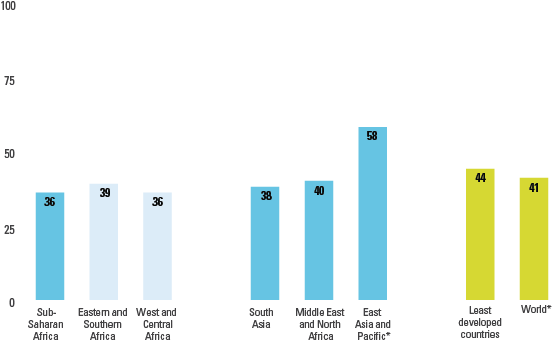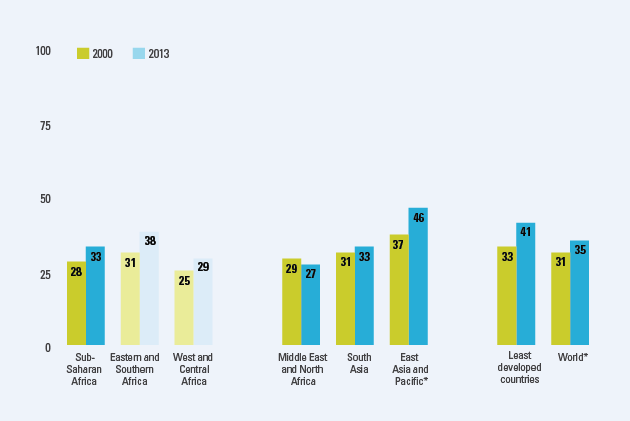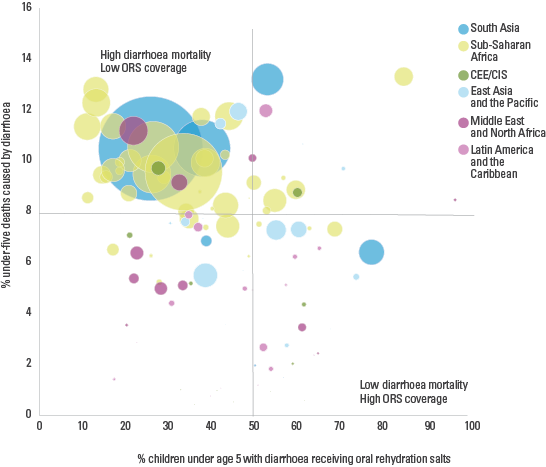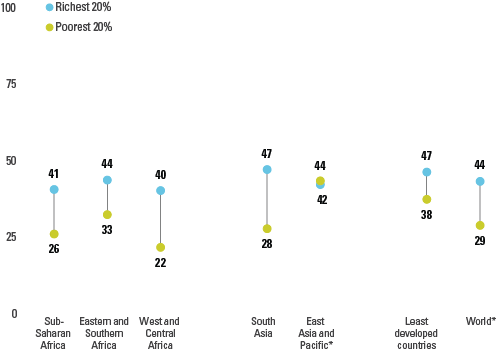The boundaries and names shown and the designations used on this map do not imply official endorsement or acceptance by the United Nations. Final boundary between the Republic of Sudan and the Republic of South Sudan has not yet been determined.
*Dotted line represents approximately the Line of Control in Jammu and Kashmir agreed upon by India and Pakistan. The final status of Jammu and Kashmir has not yet been agreed upon by the parties.
Diarrhoea remains a leading killer of young children, despite the availability of a simple treatment solution
Diarrhoea is a leading killer of children, accounting for 9 per cent of all deaths among children under age 5 worldwide. In 2013, this translated into 1,600 young children dying each day, or about 580,000 children a year. Most deaths from diarrhoea occur among children less than 2 years of age living in South Asia and sub-Saharan Africa.
Despite this heavy toll, progress is being made. From 2000 to 2013, the total annual number of deaths from diarrhoea among children under 5 decreased by more than 50 per cent – from over 1.2 million to fewer than 0.6 million.Many more children could be saved through basic interventions to improve drinking water, sanitation and hygiene (WASH) for diarrhea prevention, and the widespread use of a simple solution of oral rehydration salts (ORS) and zinc supplementation during episodes of diarrhea.
COVERAGE OF RECOMMENDED TREATMENT
Since 2004, UNICEF and the World Health Organization (WHO) have recommended treating childhood diarrhoea by replacing fluids through oral rehydration therapy. Along with continued feeding, oral rehydration salts (ORS) and zinc supplements are the recommended methods for treating diarrhoea and these could be saving the lives of hundreds of thousands of children each year if they were available to all. These interventions have proved cost-effective, affordable and relatively straightforward to implement. However, worldwide, just about 40 per cent of children under age 5 with diarrhoea receive the recommended treatment of oral rehydration therapy and continued feeding. Coverage of this treatment package is lowest in sub-Saharan Africa and South Asia (36 per cent and 38 per cent, respectively), the regions with the most deaths from diarrhoea.
Although a simple solution made from ORS is an effective treatment for childhood diarrhoea, the data indicate that just over one third (35 per cent) of children ill with diarrhoea receive it. Moreover, little progress has been made since 2000.
Countries with the highest levels of child deaths from diarrhoea have the lowest levels of ORS treatment. ORS is safe and inexpensive, yet in high-burden regions such as sub-Saharan Africa and South Asia only 1 in 3 children with diarrhoea is treated with it.
DISPARITIES IN COVERAGE
Across all regions, ORS coverage is inadequate. However, children in urban areas are still more likely to receive this recommended treatment than children in rural areas. Even among children living in cities and towns, coverage is far from optimal: Only about 4 in 10 urban children with diarrhoea receive ORS. In rural areas, just about 3 in 10 children with diarrhea receive this-life saving treatment.
In the poorest countries, children from the poorest 20 per cent of the population – those often at greatest risk of diarrhoea – are much less likely to receive ORS for the treatment of diarrhoea than children from the richest quintile. However, even among the richest quintile, less than half of children suffering from diarrhoea are treated with ORS.
REFERENCES
PLOS Medicine Collection, Measuring Coverage in Maternal, Newborn, and Child Health, vol. 10, no. 5, May 2013.
UNICEF, Committing to Child Survival: A promise renewed – Progress report 2013, UNICEF, New York, 2013.
UNICEF, Pneumonia and Diarrhoea: Tackling the deadliest diseases for the world’s poorest children, UNICEF, New York, 2012.
UNICEF and WHO, Diarrhoea: Why children are still dying and what can be done, UNICEF, New York, 2009.
WHO and UNICEF, Ending Preventable Child Deaths from Pneumonia and Diarrhoea by 2025: The integrated Global Action Plan for Pneumonia and Diarrhoea (GAPPD), WHO, Geneva, 2013.
WHO and UNICEF, WHO/UNICEF Joint Statement: Clinical management of acute diarrhoea, WHO, Geneva, 2004.









